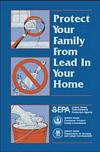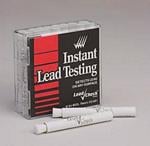What Is The Lead Disclosure Rule?
 Renovators doing RRP work will be involved with lead testing. Lead testing for RRP related projects can be done by the certified renovator, a certified lead inspector or certified lead risk assessor. The type of testing that can be done by each varies, but regardless of who does the testing written reports are required and, by law, certain individuals must be given a copy of those reports if lead is found. The EPA RRP rule is specific about who must receive test reports if the testing is done for the purposes of an RRP renovation.
Renovators doing RRP work will be involved with lead testing. Lead testing for RRP related projects can be done by the certified renovator, a certified lead inspector or certified lead risk assessor. The type of testing that can be done by each varies, but regardless of who does the testing written reports are required and, by law, certain individuals must be given a copy of those reports if lead is found. The EPA RRP rule is specific about who must receive test reports if the testing is done for the purposes of an RRP renovation.
 Regardless of the original purpose of testing (RRP or any other purpose), once a reports exists, the Lead Disclosure Rule below dictates who must receive the reports and when in regards to the selling or leasing of a property. The rule also specifies what documentation must be created and maintained to prove the reports were distributed to the required parties. Because of the considerations of the Lead Disclosure Rule, I recommend renovators get the property owner's written permission prior to conducting any lead testing.
Regardless of the original purpose of testing (RRP or any other purpose), once a reports exists, the Lead Disclosure Rule below dictates who must receive the reports and when in regards to the selling or leasing of a property. The rule also specifies what documentation must be created and maintained to prove the reports were distributed to the required parties. Because of the considerations of the Lead Disclosure Rule, I recommend renovators get the property owner's written permission prior to conducting any lead testing.
The following information is from the HUD web site:
Congress passed the Residential Lead-Based Paint Hazard Reduction Act of 1992, also known as Title X, to protect families from exposure to lead from paint, dust, and soil. Section 1018 of this law directed HUD and EPA to require the disclosure of known information on lead-based paint and lead-based paint hazards before the sale or lease of most housing built before 1978.
What is Required?
Before ratification of a contract for housing sale or lease, sellers and landlords must:
 Give an EPA-approved information pamphlet on identifying and controlling lead-based paint hazards ("Protect Your Family From Lead In Your Home" pamphlet, currently available in English, Spanish, Vietnamese, Russian, Arabic and Somali).
Give an EPA-approved information pamphlet on identifying and controlling lead-based paint hazards ("Protect Your Family From Lead In Your Home" pamphlet, currently available in English, Spanish, Vietnamese, Russian, Arabic and Somali).- Disclose any known information concerning lead-based paint or lead-based paint hazards. The seller or landlord must also disclose information such as the location of the lead-based paint and/or lead-based paint hazards, and the condition of the painted surfaces.
- Provide any records and reports on lead-based paint and/or lead-based paint hazards which are available to the seller or landlord (for multi-unit buildings, this requirement includes records and reports concerning common areas and other units, when such information was obtained as a result of a building-wide evaluation).
- Include an attachment to the contract or lease(or language inserted in the lease itself) which includes a Lead Warning Statement and confirms that the seller or landlord has complied with all notification requirements. This attachment is to be provided in the same language used in the rest of the contract. Sellers or landlords, and agents, as well as homebuyers or tenants, must sign and date the attachment.
- Sellers must provide homebuyers a 10-day period to conduct a paint inspection or risk assessment for lead-based paint or lead-based paint hazards. Parties may mutually agree, in writing, to lengthen or shorten the time period for inspection. Homebuyers may waive this inspection opportunity.
Types of Housing Covered?
Most private housing, public housing, Federally owned housing, and housing receiving Federal assistance are affected by this rule.
Effective Dates:
The regulations became effective on September 6, 1996 for transactions involving owners of more than 4 residential dwellings and on December 6, 1996 for transactions involving owners of 1 to 4 residential dwellings.
Recordkeeping:
Sellers and lessors must retain a copy of the disclosures for no less than three years from the date of sale or the date the leasing period begins.
What Can You Do?
If you did not receive the Disclosure of Information on Lead-Based Paint and/or Lead-Based Paint Hazards form when you bought or leased pre-1978 housing, contact 1-800-424-LEAD (5323).
According to the HUD web site, this content was current as of March 4, 2008. Click here to view this information on the HUD website

 Looking for accurate information about the EPA RRP rule?
Looking for accurate information about the EPA RRP rule? 
 The
The  One way to think about this might be to relate it to eating fish. The government often says that if you fish in certain bodies of polluted water, you can safely eat up to so many of the fish you catch without any health concerns. If the government says you can eat up to 3 fish a year, how safe would you feel eating even one fish? Using this analogy, how safe might the owner feel having renovations done if there is any lead present at all at their property?
One way to think about this might be to relate it to eating fish. The government often says that if you fish in certain bodies of polluted water, you can safely eat up to so many of the fish you catch without any health concerns. If the government says you can eat up to 3 fish a year, how safe would you feel eating even one fish? Using this analogy, how safe might the owner feel having renovations done if there is any lead present at all at their property? In a recent article about their efforts to address challenges for builders and remodelers due to the new EPA RRP rule, the National Association of Home Builders (NAHB) left out some critical information that causes their article to be very misleading to renovators and home owners unfamiliar with specific details about the RRP rule. In my opinion, the article also does a disservice to the manufacturer of
In a recent article about their efforts to address challenges for builders and remodelers due to the new EPA RRP rule, the National Association of Home Builders (NAHB) left out some critical information that causes their article to be very misleading to renovators and home owners unfamiliar with specific details about the RRP rule. In my opinion, the article also does a disservice to the manufacturer of  One way to think about this might be to relate it to eating fish. The government often says that if you fish in certain bodies of polluted water, you can safely eat up to so many of the fish you catch without any health concerns. If the government says you can eat up to 3 fish a year, how safe would you feel eating even one fish? Using this analogy, how safe might the home owner feel having renovations done without using lead-safe work practices if there is any lead at all present at their property? The choice should be theirs.
One way to think about this might be to relate it to eating fish. The government often says that if you fish in certain bodies of polluted water, you can safely eat up to so many of the fish you catch without any health concerns. If the government says you can eat up to 3 fish a year, how safe would you feel eating even one fish? Using this analogy, how safe might the home owner feel having renovations done without using lead-safe work practices if there is any lead at all present at their property? The choice should be theirs.

 personal desire and mission Marcia Stone has to help protect the health and well being of families and especially children. According to Marcia; “Our goal for 20 years has been to dramatically reduce lead-poisoning, especially in children where the effects are most severe and permanent. Our continued recognition as the only test kit in the EPA RRP program has given us greater reach to accomplish our goal, and we’re excited to be able to provide contractors with a low cost, easy to use, and accurate test kit to help with compliance to this rule. We are also excited about our position to help the states that are administering their own lead program, including our home state of Massachusetts.”
personal desire and mission Marcia Stone has to help protect the health and well being of families and especially children. According to Marcia; “Our goal for 20 years has been to dramatically reduce lead-poisoning, especially in children where the effects are most severe and permanent. Our continued recognition as the only test kit in the EPA RRP program has given us greater reach to accomplish our goal, and we’re excited to be able to provide contractors with a low cost, easy to use, and accurate test kit to help with compliance to this rule. We are also excited about our position to help the states that are administering their own lead program, including our home state of Massachusetts.” EPA Communication to EPA Region Headquarters:
EPA Communication to EPA Region Headquarters:


